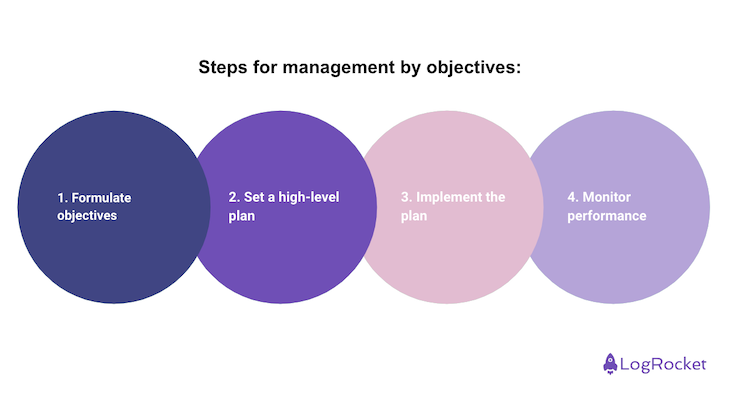My first contact with product teams happened in 2008. Since then, I’ve worked with dozens of teams worldwide, from startups to well-established corporations. After all this time, two things stick out: in teams where purpose or accountability was missing, the results were watered down.

Without knowing why their work matters, teams cannot make better decisions about how to create value. And with limited accountability, team members won’t bring their best to work.
To succeed you need both purpose and accountability. But now comes the trick, I often notice that management sets goals and throws them over the fence to teams. The result is almost always the same, teams complain, don’t commit, and get demotivated.
How do you change this scenario for the better? That’s when management by objectives comes in handy.
In this article, you will learn what management by objectives is, the four steps that go into it, and real world examples of its implementation within product teams.
Management by objective is a style of leadership that empowers teams and individuals by setting goals collaboratively. The belief is that individuals are self-managing and fully capable of reaching goals without management telling them precisely what to do.
Unlike the hierarchical leadership style, where the higher you’re in the organization, the more decisions you make, and the lower you are, the more orders you follow. MBO is about collaborating on setting goals and crafting high-level plans together.
MBO relies on trust and strong collaboration that leads to higher accountability and purpose.
Product management is complex. No matter what you do, you won’t get all the answers right from the first attempt. Yet, where you want to land around a stable objective.
In hierarchical leadership, the C-Suite defines what needs to be done by when and forces teams to commit to it. The challenge is that teams need to focus on outputs without the empowerment to experiment with different solutions to reach the desired outcomes.
This way, they have only one chance of succeeding. If the defined output is correct, they will thrive. Otherwise, they will likely fail.
Let me illustrate the difference between a classic leadership style and MBO:
Both approaches can lead to success, but the first would force the team to have a fixed mindset because delivering the solution is the goal. That causes a lack of accountability and purpose.
On the other hand, the second points out the direction but doesn’t define how. The team would focus on reaching the goal while having the chance to explore different solutions.
MBO paves the way for product teams to thrive by allowing them to collaborate on crafting goals together and aligning on a high-level plan. It’s collaborative instead of coordinative.
To set up management by objectives, you’ll need to follow the following four steps:

You may wonder, is that all? The beauty of management by objectives lies in its simplicity.
Setting goals together is fundamental to enabling accountability and creating purpose, but that alone isn’t enough. Teams get things wrong and will need support. Help find the best way forward.
The shorter the cycle you can measure, the faster you can correct issues.
Some teams create long cycles to monitor their results, but that tends to be ineffective. You may realize you have a problem once it’s already too big. Monitoring your results as fast as possible (weekly is good enough) can identify opportunities to improve the outcomes.
Monitoring enables you to:
One of the tricky aspects of MBO is learning how to balance collaboration between leadership and individuals. Leadership holds higher cards, and it’s unlikely that individuals will go against them, even though leadership may want to get their perspectives before agreeing on goals.
When leadership names a rough objective, chances are high that individuals won’t challenge the direction. This creates a follow-the-leader approach, and accountability will be lower than desired.
To make management by objective more effective, utilize storytelling. For example, instead of saying that growth is the utmost important metric now, try saying that over the last couple of months, increasing the customer base has been a struggle. Then you can ask for individual feedback.
By involving individuals and teams in crafting the objective, they will feel more accountable for it, and that creates a leader-leader approach.
I worked for an agency in Brazil that audited stores nationwide. Our service helped brands like Adidas, Samsung, Philips, and others understand how their products were positioned in stores compared to competitors and how well-prepared the sales representatives were.
The company had more than five thousand employees spread across Brazil, and our biggest challenge was effective route planning. Once the operations director came to our team to align on what we could achieve for the upcoming months. She said, “We’re ineffective. Despite having a strong workforce, we’re not covering the stores we promised our customers. We need to change this situation. I need your help.”
The message was clear, and the humbleness of the director touched us. We bounced ideas, like automating store distribution, partnering with other agencies to outsource the routing, or even creating an advanced routing system. The director liked the direction but told us, “These are solutions. Which objective could we commit to?”
Someone from the team said, “What about Covering 20 percent more stores in three months than we cover now?” That resonated with everyone, and we set the goal. Then, together we worked on a high-level plan, which consisted in trying out three solutions at a high level to evaluate which would yield better results, and we agreed to meet again in two weeks.
Two weeks passed, and we met. Two solutions created nothing relevant, but one looked promising, so we decided to drop the losers and double down on the winner.
We worked like this for the next three months and reached our goal. My takeaway from this lesson was that collaboration beats the process. You will make significant progress once you craft objectives together and collaborate to get there.
Everyone felt accountable for the objective, and we connected to the purpose of it.
Management by objective is potent when done right, but knowing how to get employees to speak up is essential.
Remember these key takeaways from combining MBO with product management:
Featured image source: IconScout
LogRocket identifies friction points in the user experience so you can make informed decisions about product and design changes that must happen to hit your goals.
With LogRocket, you can understand the scope of the issues affecting your product and prioritize the changes that need to be made. LogRocket simplifies workflows by allowing Engineering, Product, UX, and Design teams to work from the same data as you, eliminating any confusion about what needs to be done.
Get your teams on the same page — try LogRocket today.

Trey Courtney talks about his process for evaluating partnerships or acquisitions and how he successfully implements these initiatives.

Asma Syeda shares the importance of responsible AI and best practices for companies to ensure their AI technology remains ethical.

What hard skills do PMs need in 2025? Learn how AI tools can help you level up in SQL, Figma, A/B testing, and more.

Paul Weston talks about “quantifying the unquantifiable,” i.e., bringing in objective data for things that otherwise seem hard to measure.